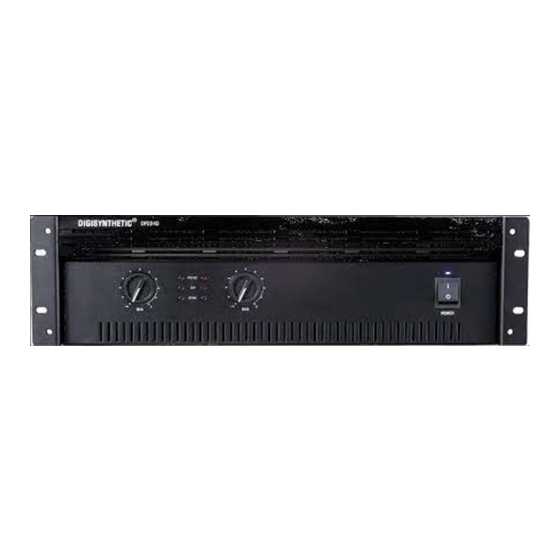DIGISYNTHETIC DP Series Manuel de l'utilisateur - Page 8
Parcourez en ligne ou téléchargez le pdf Manuel de l'utilisateur pour {nom_de_la_catégorie} DIGISYNTHETIC DP Series. DIGISYNTHETIC DP Series 13 pages. Excellent power amplifier
Également pour DIGISYNTHETIC DP Series : Manuel de l'utilisateur (11 pages)

3. Connect the input and output cables as shown in the Only channel input is used.
4. Turn on the amplifier and adjust both level controls.
CAUTION: Never strap the two red output terminals together (in parallel). Never
connect either red output terminal to chassis ground.
IMPORTANT: The channel 2 level control will remain illuminated when operating in
Parallel/M-ono mode.
4.3
Additional Load Protection
To protect against excessive power, a fuse can be added in series with each
loudspeaker cable. A single fuse can protect the entire system, or can be used for each
driver. High frequency drivers (tweeters) are usually more sensitive to large voltage
peaks, while low-frequency drivers (woofers) are typically most sensitive to the heat from
average RMS output power. To protect your tweeters, we recommend that you use a
high-speed instrument fuse like the Little fuse 361000 series. To protect your woofers,
we recommend using a slow-blow fuse that more closely represents the thermal
response of your woofer. Use Figure 2-6 to find the correct value for either type of fuse.
4.4
RequiredAC Mains
All DP Series amplifiers are shipped with an appropriate line cord and plug. When
possible, use a power receptacle on a dedicated circuit; and always, make sure it will
provide the correct voltage and sufficient current. We do not recommend operating your
amplifier with voltages greater than 10% above or below the unit's rated voltage. For
example, if your amplifier is rated for 220 VAC, the line voltage should not exceed 240
VAC.
CAUTION: Connect unit only to a proper supply. Use only three wire cord which is
provided with unit.
5.operating instruction
5.1 Precautions
Although your amplifier is protected from external faults, the following safety precautions
are recommended:
1. There are important differences among the Stereo, Bridge-Mono and Parallel-Mono
operating modes. Please refer to Section 2 for additional information.
2.
WARNING Do not change the position of the stereo/mono switch unless the
:
amplifier is first turned off .
CAUTION: Never strap the two red output terminals together (in parallel). Never
connect either red output terminal to chassis ground.
Also, make sure the Stereo/Mono switch is set to the proper position.
3. Use care when making connections, selecting signal sources and controlling the
output level.
Page 7
